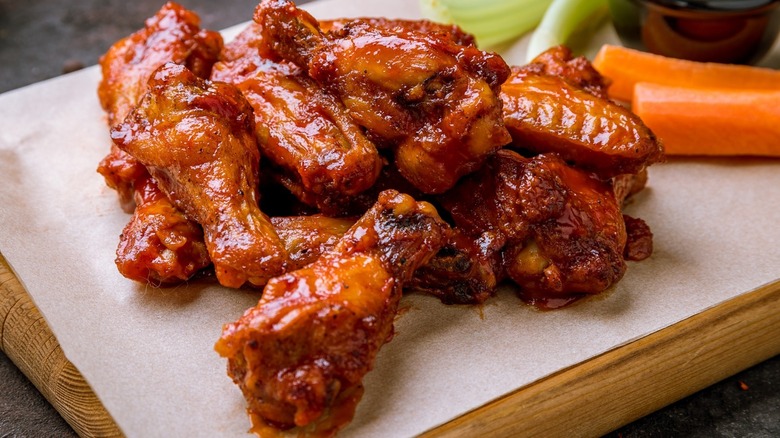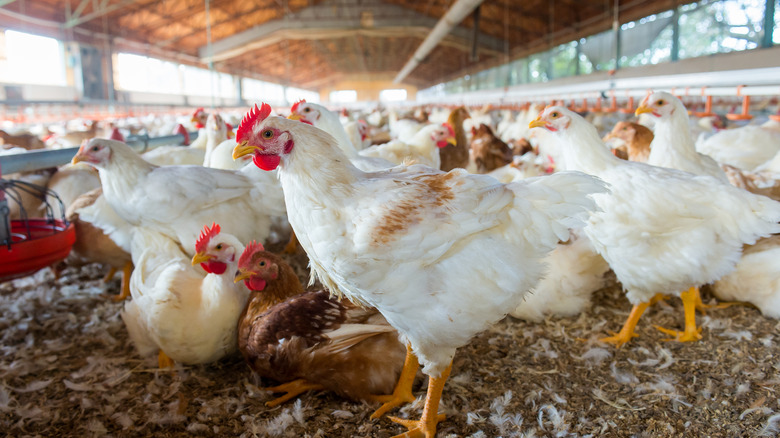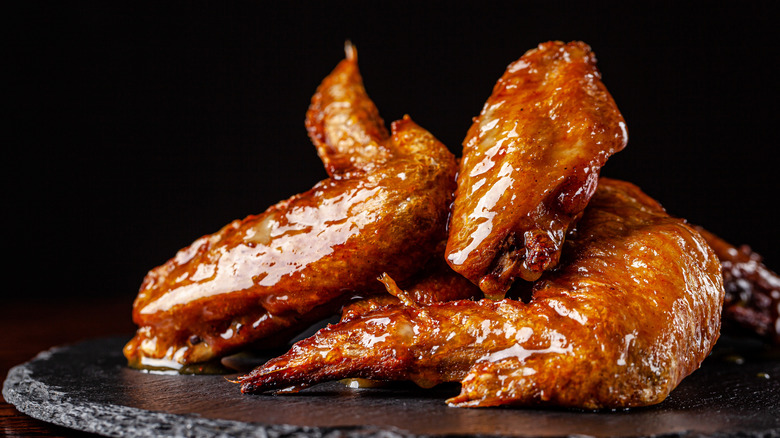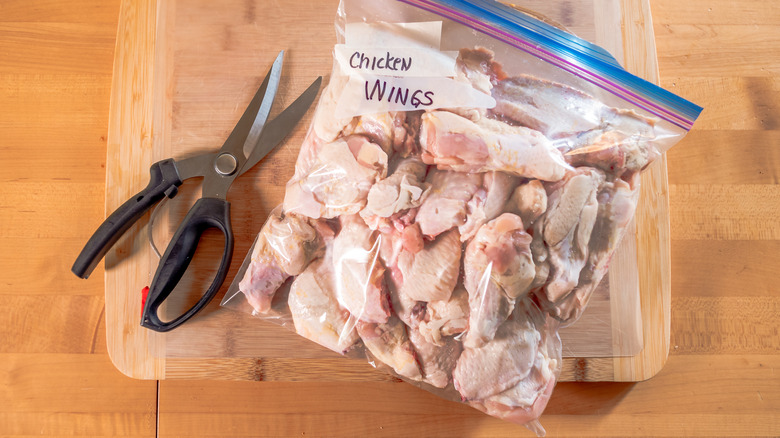Why Restaurants Are Struggling To Sell Chicken Wings Right Now
At the start of the pandemic, chicken wings underwent what some might call a cultural reset. What once was seen as an occasional appetizer became an everyday meal as people turned to cheap, reliable delivery food to eat from the comfort of their homes. Per Bloomberg, in the first quarter of 2020 sales at popular wing chain Wingstop went up by nearly 31.9%. And it didn't take long for other eateries to take note of the craze. According to The Verge, restaurants that didn't previously sell wings suddenly added them to menus, and national wing sales between April 2020 and February 2021 increased by 10%.
A year later, the majority of restaurants in the U.S. have reopened fully. But people aren't quite as wild about wings as they used to be. What happened? The short explanation is pretty straightforward: Wings became more expensive due to inflation. And we're not talking like a mere 10% or 20% more expensive. One restaurant owner told Bloomberg that an order of wings at their restaurant once sold for $13.95 pre-pandemic now sets customers back a whopping $27.95. That's more than a 100% price hike in less than three years.
Bloomberg noted that some restaurants initially tried to fix this by simply eating the loss (easier for bigger corporations) or cutting staff, but now, even that has become insufficient. In order for chicken wings to stay on the menu, the extra cost is placed on the customer.
Multiple factors are causing chicken prices to skyrocket
High gas prices have played a significant role in driving up the price of food at restaurants, with its effects being felt at every level of the supply chain. One farmer told WTVT in April that the price of feed for chickens in his area had gone up by nearly 20%, which resulted in them reducing the number of chickens on their farm. Take that one farmer and multiple it by thousands and add in the fact that an avian flu outbreak recently killed 22 million birds, and it means there are even fewer chickens (and wings) available, in turn driving up the price.
Of course, because these issues have affected the cost of chicken in general, one may still wonder why wings specifically are taking a hit. Bloomberg reported that people are still buying chicken at the store despite the price hikes.
Equally important to consider is that increased gas prices not only affect the literal cost of chicken wings, but also the financial burden placed on the customers who have to drive to restaurants to get them. Because wings are commonly ordered as an appetizer rather than an entree, they're potentially less of a priority for consumers who are being more selective with what they buy. As economist Paul Aho put it in The Washington Post, "When gasoline prices get high people have less money to spend on wings at the bar on Saturday night."
From rags to riches
You wouldn't know it from looking at wing prices on a menu these days, but before their fated invention in a bar on the outskirts of Buffalo — a story that's immortalized in a somewhat canonical New Yorker article from 1980 — wings weren't even considered worthy of human consumption. Per The Washington Post, the wings of mass-produced chickens "were often rendered into animal feed," while the golden child of the bird body, the breast, was (and still is) considered the most prized part of the chicken. Fast-forward to the early 1980s, and wings were getting a bigger spotlight than ever with the debut of Buffalo Wild Wings, which remains one of the most well-known places to nosh on the once-overlooked poultry appendage.
While Buffalo Wild Wings has been struggling from increased chicken prices like every other poultry purveyor, wings are obviously still its main draw. If the chain followed the lead of some restaurants by taking wings off its menu, it would have to close up shop altogether, as would its competitor Wingstop.
Judging from B-Dubs' spicy new Doritos-flavored sauce, the chain is turning to some creative ways to keep people interested in its nominal product, even if it means asking customers to shell out extra cash.
Restaurants are burning thorugh their backup chicken
Just as wholesale wing prices reached a record high of $3.25 per pound last May, "cold stocks" of wings enjoyed a recovery that lasted throughout the rest of the year, according to a USDA report. However, a later report shows that supplies of broiler meat (aka chicken) in cold storage subsequently dipped to "record lows."
Speaking of extreme temperatures, some say another factor of the nationwide chicken shortage is due to climate change. Remember the North American storm that ripped through Texas last winter? As a major source of the nation's chicken supply, the freezing weather that struck the Lone Star State had a big impact on its poultry farms, per Poultry World. What's more, the recovery response of mass chicken production leads to even more climate woes, according to Vox. This won't come as a shock to anyone who's made the switch to plant-based meat alternatives lately, as information regarding the environmental tolls of meat production is becoming more widely spread. The Guardian's Jess Fanzo and Mario Herrero write that mass livestock farming alone comprises 15% of global greenhouse gas emissions, which facilitate events like deforestation and species extinction.
The New York Times recently reported on an increased demand for laboratory-grown meat, so if all these chicken issues don't sort themselves out, perhaps science poultry will save the day.



